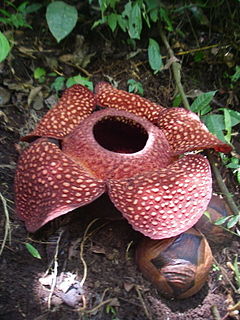
Rafflesia is a genus of parasitic flowering plants in the family Rafflesiaceae. The species have enormous flowers, the buds rising from the ground or directly from the lower stems of their host plants; one species has the largest flowers in the world. The genus contains approximately 28 species, all found in Southeast Asia, mainly in Indonesia, Malaysia, Thailand and the Philippines. For Western Europe, it was first discovered by French surgeon and naturalist Louis Deschamps in Java between 1791 and 1794, but his notes and illustrations, seized by the British in 1803, were not available to western science until 1861. The first British person to see one was Joseph Arnold in 1818, in the Indonesia rainforest in Bengkulu, Sumatra, after a Malay servant working for him discovered a flower and pointed it out to him. It was later named after Stamford Raffles, the leader of the expedition.

Senecio is a genus of flowering plants in the daisy family (Asteraceae) that includes ragworts and groundsels. The scientific Latin genus name, Senecio, means "old man".

Senecioneae is the largest tribe of the Asteraceae, or the sunflower family, comprising about 150 genera and 3,000 species. Almost one-third of the species in this tribe are placed in the genus Senecio. Its members exhibit probably the widest possible range of form to be found in the entire plant kingdom, and include annuals, minute creeping alpines, herbaceous and evergreen perennials, shrubs, climbers, succulents, trees, and semiaquatic plants.
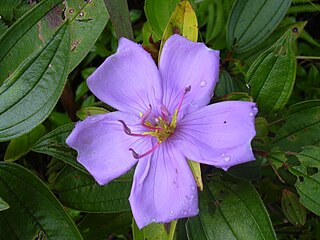
Melastoma is a genus in the family Melastomataceae. It has over 100 species distributed around Southeast Asia, India, north to Japan, south to Australia and the Pacific Islands. The number of species should probably be reduced according to some sources. Many species have been planted around the world for the aesthetic value of their bright purple flowers.

Jacobaea is a genus of flowering plants in the tribe Senecioneae and the family Asteraceae. Its members used to be placed in the genus Senecio, but have been separated into the segregate genus Jacobaea on the basis of molecular phylogenetics in order to maintain genera that are monophyletic. The following species are recognised by The Plant List:
Talamancalia is a genus of flowering plant in the family Asteraceae. It contains the following species:

Amyema is a genus of semi-parasitic shrubs (mistletoes) which occur in Malesia and Australia.
Rune Bertil Nordenstam is a Swedish botanist and professor emeritus at the Swedish Museum of Natural History in the Department of Phanerogamic Botany. He has worked with Colchicaceae, Senecioneae and Calenduleae, was the editor of Compositae Newsletter newsletter since 1990, and is a Tribal Coordinator for The International Compositae Alliance with responsibility for the tribes Calenduleae and Senecioneae.
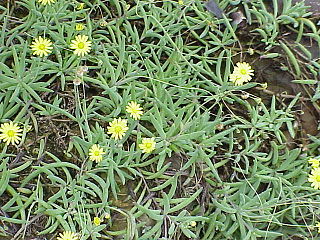
Crassothonna capensis, also known as little pickles (USA), ruby necklace (Australia), Cape aster, Cape Othonna, and Bobbejaankool (Afrikaans), is a species of the genus Crassothonna previously (Othonna) in the family Asteraceae, and is a native of the Eastern Cape of South Africa. It is a native highveld species that originates from the southern Drakensberg region.
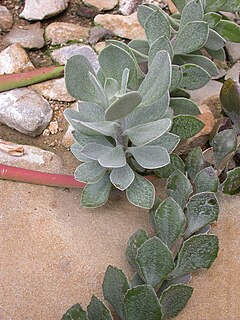
Caputia medley-woodii is a species of flowering plant in the sunflower family, Asteraceae.

Pieter B. Pelser is a Lecturer in Plant Systematics and the curator of the herbarium at the University of Canterbury in Christchurch, New Zealand. One research interest is the evolutionary history of the tribe Senecioneae, one of the largest tribes in the largest family of flowering plants. He wrote the most recent attempt to define and delimit this tribe and its problematic founding species Senecio. He also studies insects that eat these plants (Longitarsus) which contain pyrrolizidine alkaloids and what makes them choose which plants they eat.
Rafflesia philippensis is a parasitic plant species of the Rafflesiaceae family that was named by Francisco Manuel Blanco in his Flora de Filipinas in 1845. The species is known only from a mountain located between the provinces of Laguna and Quezon, Luzon where it was first discovered. Its plant host is Tetrastigma pisicarpum. This species went unnoticed since its first description by Blanco but was rediscovered in 2003 by members of the Tanggol Kalikasan, a local environment conservation group in Quezon province who first saw and photographed the open flower of this species. It was brought to the attention of Manuel S. Enverga University (MSEUF), who formed a team composed of students and faculty to document the newly discovered Rafflesia species.
Rafflesia leonardi is a parasitic plant species of the genus Rafflesia. It is endemic to the Philippines. Rafflesia banaoana is considered to be a synonym by some sources, but is recognized as a separate species by others. R. leonardi is the fourth Rafflesia species found in Luzon and the eighth from the Philippines. It is called ngaratngat by the local Agta tribesmen.

Tephroseris is a genus of Eurasian and North American plants in the groundsel tribe within the daisy family.
Julie F. Barcelona is a Filipina botanist and taxonomist working as Research Associate at University of Canterbury. She is mostly known for her research on the Philippine members of the genus Rafflesia.
Nepenthes barcelonae is a tropical pitcher plant native to the Philippine island of Luzon. It is known from a single mountain in the Sierra Madre range of Aurora Province, where it grows in stunted submontane forest.
Lepeostegeres cebuensis is a species of mistletoe recently described which is found on Cebu Island, Philippines. Currently this is treated as an unplaced name by Plants of the world online.

Daniel Lee Nickrent is an American botanist, working in plant evolutionary biology, including the subdisciplines of genomics, phylogenetics, systematics, population genetics, and taxonomy. A major focus has been parasitic flowering plants, particularly of the sandalwood order (Santalales). His interest in photographic documentation and photographic databases has led to several photographic databases including Parasitic Plant Connection, Phytoimages, Plant Checklist for the Rocky Mountain National Park, and Plant Checklist for the Crab Orchard National Wildlife Refuge.
Amyema nickrentii is an epiphytic, flowering, hemiparasitic plant of the family Loranthaceae native to the Philippines. It was found in coastal forest in the Aurora Province and "differs from all other described Amyema species in having a whorled leaf arrangement with mostly nine flat linear leaves per node".
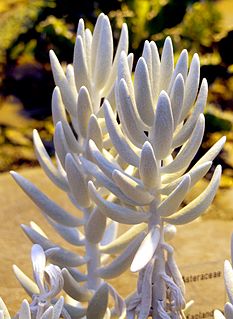
Caputia is a small genus of flowering plants in the family Asteraceae, native to South Africa. It may be of hybrid origin. Species in this genus were formerly considered part of the genus Senecio.











